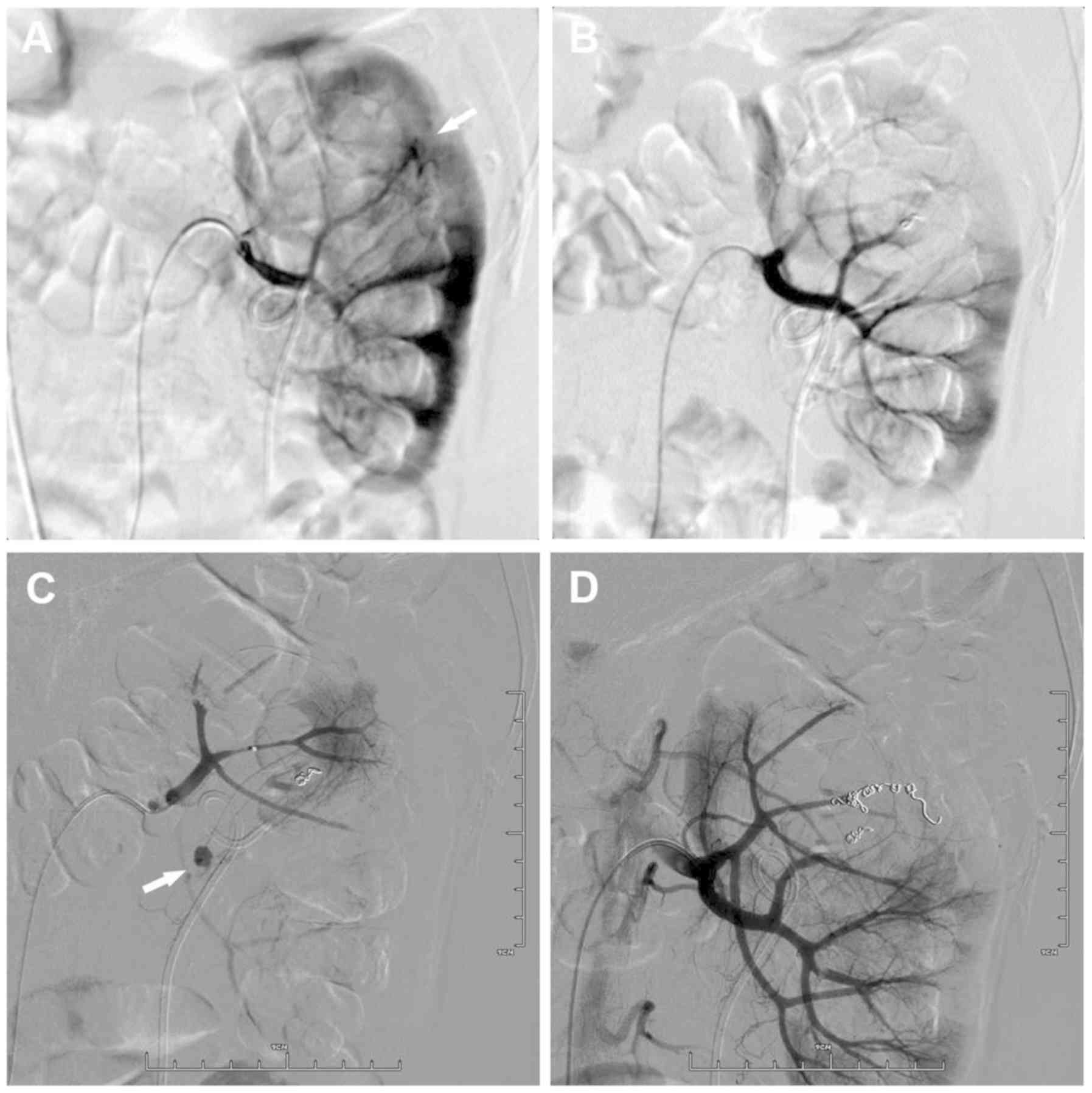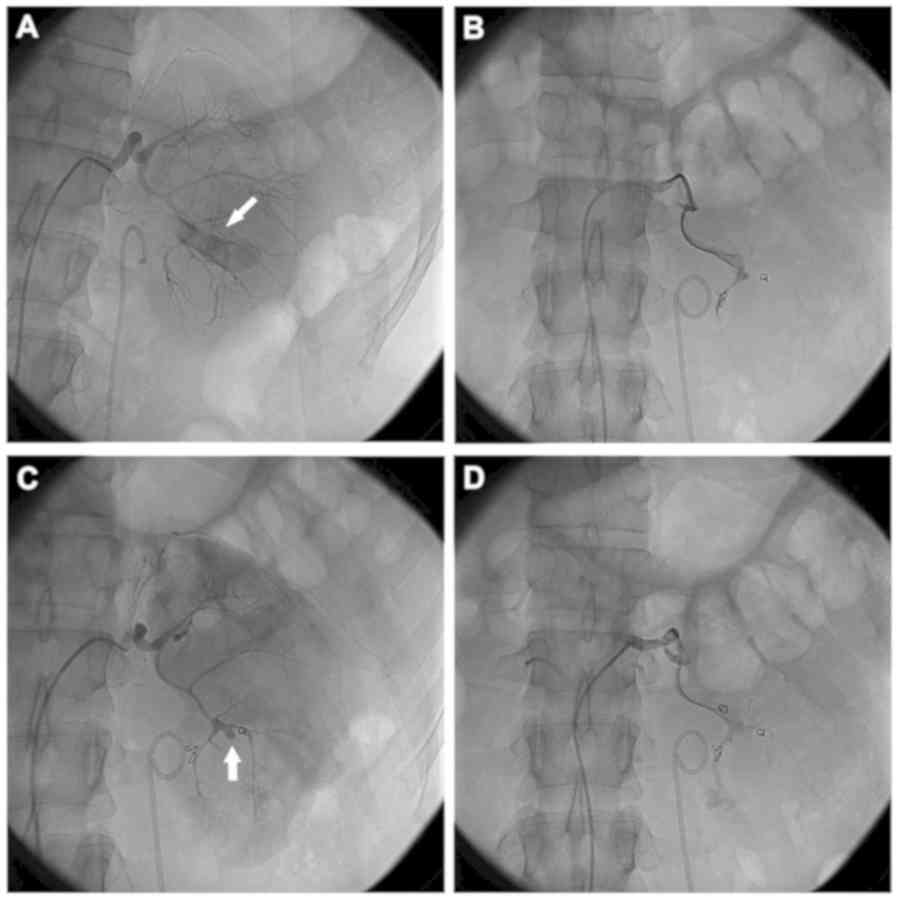|
1
|
Preminger GM, Assimos DG, Lingeman JE,
Nakada SY, Pearle MS and Wolf JS Jr; AUA Nephrolithiasis Guideline
Panel, : Chapter 1: AUA guideline on management of staghorn
calculi: Diagnosis and treatment recommendations. J Urol.
173:1991–2000. 2005. View Article : Google Scholar : PubMed/NCBI
|
|
2
|
Martin X, Murat FJ, Feitosa LC, Rouvière
O, Lyonnet D, Gelet A and Dubernard J: Severe bleeding after
nephrolithotomy: Results of hyperselective embolization. Eur Urol.
37:136–139. 2000. View Article : Google Scholar : PubMed/NCBI
|
|
3
|
Gallucci M, Fortunato P, Schettini M and
Vincenzoni A: Management of hemorrhage after percutaneous renal
surgery. J Endourol. 12:509–512. 1998. View Article : Google Scholar : PubMed/NCBI
|
|
4
|
Bookstein JJ and Ernst CB: Vasodilatory
and vasoconstrictive pharmacoangiographic manipulation of renal
collateral flow. Radiology. 108:55–59. 1973. View Article : Google Scholar : PubMed/NCBI
|
|
5
|
Chuang VP, Reuter SR, Walter J, Foley WD
and Bookstein JJ: Control of renal hemorrhage by selective arterial
embolization. Am J Roentgenol Radium Ther Nucl Med. 125:300–306.
1975. View Article : Google Scholar : PubMed/NCBI
|
|
6
|
Beaujeux R, Saussine C, al-Fakir A,
Boudjema K, Roy C, Jacqmin D and Bourjat P: Superselective
endo-vascular treatment of renal vascular lesions. J Urol.
153:14–17. 1995. View Article : Google Scholar : PubMed/NCBI
|
|
7
|
El Tayeb MM, Knoedler JJ, Krambeck AE,
Paonessa JE, Mellon MJ and Lingeman JE: Vascular complications
after percutaneous nephrolithotomy: 10 years of experience.
Urology. 85:777–781. 2015. View Article : Google Scholar : PubMed/NCBI
|
|
8
|
Wang C, Mao Q, Tan F and Shen B:
Superselective renal artery embolization in the treatment of renal
hemorrhage. Ir J Med Sci. 183:59–63. 2014. View Article : Google Scholar : PubMed/NCBI
|
|
9
|
Keller FS: Interventional radiology: New
paradigms for the new millennium. J Vasc Interv Radiol. 11:677–681.
2000. View Article : Google Scholar : PubMed/NCBI
|
|
10
|
Schwartz MJ, Smith EB, Trost DW and
Vaughan ED Jr: Renal artery embolization: Clinical indications and
experience from over 100 cases. BJU Int. 99:881–886. 2007.
View Article : Google Scholar : PubMed/NCBI
|
|
11
|
Keoghane SR, Cetti RJ, Rogers AE and
Walmsley BH: Blood transfusion, embolisation and nephrectomy after
percutaneous nephrolithotomy (PCNL). BJU Int. 111:628–632. 2013.
View Article : Google Scholar : PubMed/NCBI
|
|
12
|
Ganpule AP, Shah DH and Desai MR:
Postpercutaneous nephrolithotomy bleeding: Aetiology and
management. Curr Opin Urol. 24:189–194. 2014. View Article : Google Scholar : PubMed/NCBI
|
|
13
|
Rastinehad AR, Andonian S, Smith AD and
Siegel DN: Management of hemorrhagic complications associated with
percutaneous nephrolithotomy. J Endourol. 23:1763–1767. 2009.
View Article : Google Scholar : PubMed/NCBI
|
|
14
|
Jain V, Ganpule A, Vyas J, Muthu V, Sabnis
RB, Rajapurkar MM and Desai MR: Management of non-neoplastic renal
hemorrhage by transarterial embolization. Urology. 74:522–526.
2009. View Article : Google Scholar : PubMed/NCBI
|
|
15
|
Kessaris DN, Bellman GC, Pardalidis NP and
Smith AG: Management of hemorrhage after percutaneous renal
surgery. J Urol. 153:604–608. 1995. View Article : Google Scholar : PubMed/NCBI
|
|
16
|
Lee JK, Kim BS and Park YK: Predictive
factors for bleeding during percutaneous nephrolithotomy. Korean J
Urol. 54:448–453. 2013. View Article : Google Scholar : PubMed/NCBI
|
|
17
|
El-Nahas AR, Shokeir AA, El-Assmy AM,
Mohsen T, Shoma AM, Eraky I, El-Kenawy MR and El-Kappany HA:
Post-percutaneous nephrolithotomy extensive hemorrhage: A study of
risk factors. J Urol. 177:576–579. 2007. View Article : Google Scholar : PubMed/NCBI
|
|
18
|
Kukreja R and Desai M, Patel S, Bapat S
and Desai M: Factors affecting blood loss during percutaneous
nephrolithotomy: Prospective study. J Endourol. 18:715–722. 2004.
View Article : Google Scholar : PubMed/NCBI
|
|
19
|
Srivastava A, Singh KJ, Suri A, Dubey D,
Kumar A, Kapoor R, Mandhani A and Jain S: Vascular complications
after percutaneous nephrolithotomy: Are there any predictive
factors? Urology. 66:38–40. 2005. View Article : Google Scholar : PubMed/NCBI
|
|
20
|
Zeng G, Zhao Z, Wan S, Khadgi S, Long Y,
Zhang Y, Cao G and Yang X: Failure of initial renal arterial
embolization for severe post-percutaneous nephrolithotomy
hemorrhage: A multicenter study of risk factors. J Urol.
190:2133–2138. 2013. View Article : Google Scholar : PubMed/NCBI
|
|
21
|
Resorlu B, Kara C, Ozyuvali E and Unsal A:
Percutaneous nephrolithotomy in hypertensive patients with
different sizes of instruments. Acta Chir Belg. 111:228–231. 2011.
View Article : Google Scholar : PubMed/NCBI
|
|
22
|
Desai J and Solanki R: Ultra-mini
percutaneous nephrolithotomy (UMP): One more armamentarium. BJU
Int. 112:1046–1049. 2013.PubMed/NCBI
|
|
23
|
Desai J, Zeng G, Zhao Z, Zhong W, Chen W
and Wu W: A novel technique of ultra-mini-percutaneous
nephrolithotomy: Introduction and an initial experience for
treatment of upper urinary calculi less than 2 cm. Biomed Res Int.
2013:4907932013. View Article : Google Scholar : PubMed/NCBI
|
|
24
|
Akman T, Binbay M, Sari E, Yuruk E,
Tepeler A, Akcay M, Muslumanoglu AY and Tefekli A: Factors
affecting bleeding during percutaneous nephrolithotomy: Single
surgeon experience. J Endourol. 25:327–333. 2011. View Article : Google Scholar : PubMed/NCBI
|
|
25
|
Patterson DE, Segura JW, LeRoy AJ, Benson
RC Jr and May G: The etiology and treatment of delayed bleeding
following percutaneous lithotripsy. J Urol. 133:447–451. 1985.
View Article : Google Scholar : PubMed/NCBI
|
















